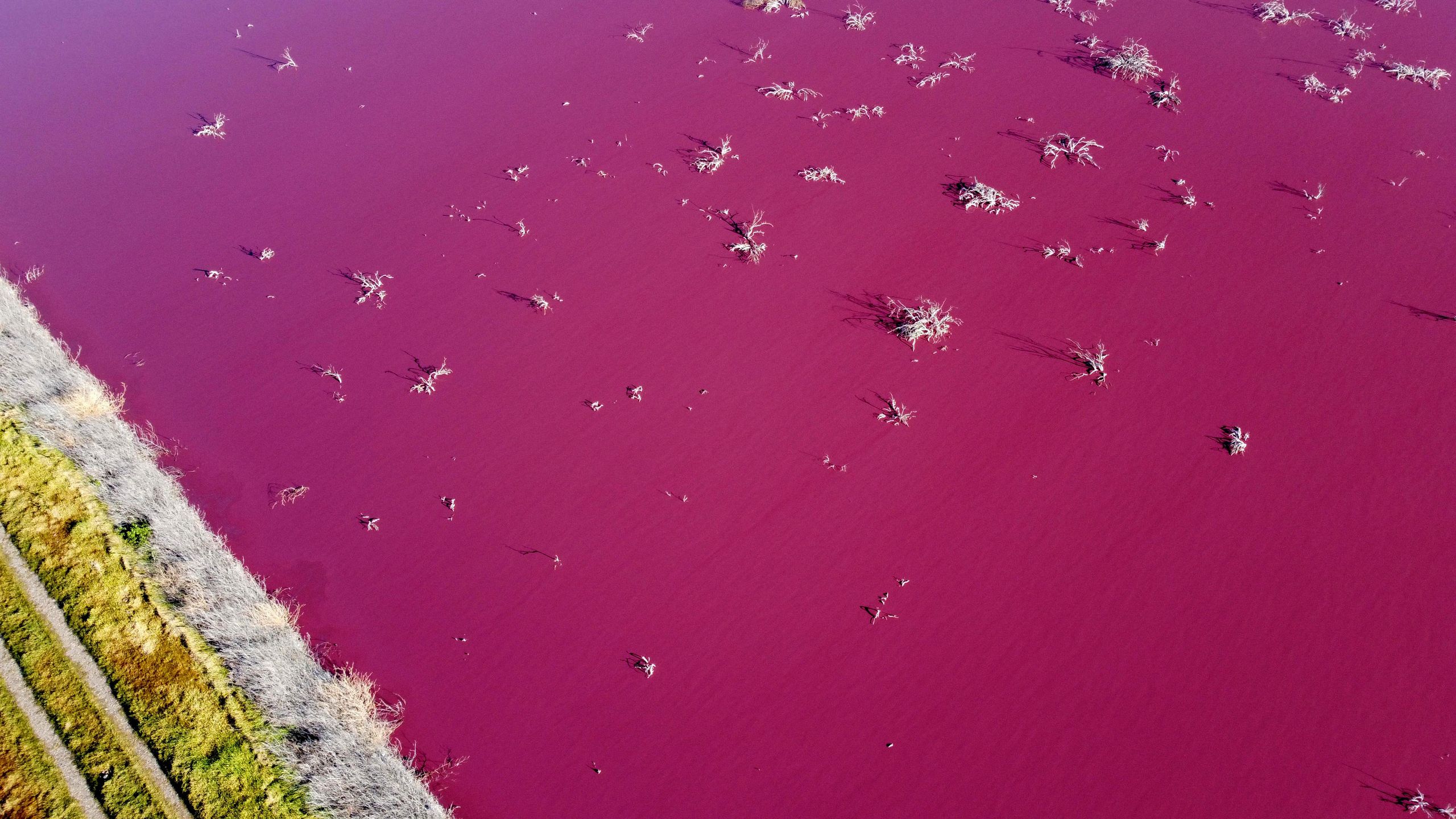Pink lagoon and peculiar galaxies — July’s best science images
The month’s sharpest science shots, selected by Nature’s photo team.

Pink pollution. Contamination from fish factories stained the water hot pink in this lagoon in Chubut, a Patagonian province of Argentina. The bright hue is caused by sodium sulfite, an antibacterial compound used to preserve shrimp. When protests stopped trucks that were carrying fish waste through the town of Rawson to treatment plants, Chubut authorities gave factories permission to dump their waste in the lagoon. The province’s environmental-control chief Juan Micheloud claims that the pink colour “does not cause damage”. But local environmental activists have condemned the move and expressed concern that the waste could be harmful to wildlife.
Deep-sea safari. Marine scientists aboard the research vessel Falkor, which belongs to the Schmidt Ocean Institute in Palo Alto, California, have explored nine seamounts in the remote Phoenix Islands Archipelago for the first time. In a 34-day expedition, the researchers mapped more than 30,000 square kilometres of the sea floor at high resolution and spotted a plethora of deep-sea organisms. Among their observations was this rare glass octopus (Vitreledonella richardi). It is almost completely colourless except for its internal organs and colour-producing cells called chromatophores, seen here as yellow dots.
The team also photographed a 30-centimetre-long sea star preying on bamboo coral — a behaviour that had never been seen before.
Their finds included this Venus flytrap sea anemone (Actinoscyphia aurelia).
And this tiny squat lobster sitting on a golden coral.
Credit: Schmidt Ocean Institute

Credit: Tony Gutierrez/AP/Shutterstock
Credit: Tony Gutierrez/AP/Shutterstock
Space at last. On 20 July, aviator Wally Funk (right) travelled to space in a capsule made by Blue Origin, a US aerospace firm, alongside billionaire Jeff Bezos (centre), his brother Mark (left) and an 18-year-old physics student. Here, Funk describes the “incredible” trip in a postflight briefing at the spaceport near Van Horn, Texas. At 82 years old, Funk is the oldest space traveller ever. She is one of the Mercury 13 — 13 women who excelled at the tests designed for the male astronauts of NASA’s first human space-flight programme in the 1960s, but never went to space themselves.

Hubble rebooted. This galactic snapshot is among the first taken by the Hubble Space Telescope following its return to full science operations in mid-July. The galaxy shown has three unusually extended spiral arms that stretch out to create a radius three times more expansive than that of the Milky Way. The image is part of a project to survey ‘oddball’ galaxies across the sky. Hubble’s observations were suspended for more than a month while engineers worked to fix a problem with the telescope’s payload computer, which controls its on-board science instruments.

Credit: Jon Cherry/Getty
Credit: Jon Cherry/Getty
Mysterious deaths. US wildlife agencies are working with diagnostic laboratories to investigate an unexplained illness that seems to be killing birds across several states. Here, wildlife-veterinarian Christine Casey examines the bodies of birds found in Kentucky, where more then 250 are thought to have been affected. Casey says that there are probably ‘multiple factors’ contributing to the mystery illness, which causes eye swelling and neurological problems, and that researchers are working on understanding the possible roles of bacteria and toxicology.

Credit: Li Qiang
Credit: Li Qiang
Ancient bat. This fossilized tooth belonged to a bat that lived around 50 million years ago. It is one of the oldest bat fossils to be found in Asia. Researchers uncovered two tooth fragments in northwest China in a process they say was like “panning for gold”. The discovery could shed some light on mysteries surrounding the evolution of bats: researchers now know that bats were living in several parts of the world, including Asia, by the early Eocene epoch. But it is impossible to tell from a tooth fragment how much its owner resembled modern bats: crucial details, including whether it could fly or echolocate, remain a mystery.

Credit: Rhein-Erft-Kreis/dpa via ZUMA Press
Credit: Rhein-Erft-Kreis/dpa via ZUMA Press
Flash floods. Record rainfall in western Germany led to catastrophic flooding and widespread chaos as rivers burst their banks and water overwhelmed farmland, towns and cities. This enormous sinkhole opened up at a gravel quarry near the town of Erftstadt, where thousands of residents had to be evacuated amid the destruction of buildings, roads and vehicles. Belgium, the Netherlands, Switzerland and Luxembourg have also experienced heavy rain and flooding this summer.

White whales. Around 1 in 1,000 orcas in the western north Pacific are white. There have been several sightings before, but this is thought to be the first time two white orcas have been seen together. Whale watchers spotted this pair off the coast of Japan on 24 July. Their colour could be caused by albinism or leucism — conditions that affect the production of dark pigmentation in the skin. The visible scratches on their bodies are rake marks made by the teeth of other orcas, possibly from play-fighting. Black-and-white orcas have these, too, but they show up more easily on pale skin.

Credit: Noah Berger/AP/Shutterstock
Credit: Noah Berger/AP/Shutterstock
Burning up. Firefighters prepare to battle the Sugar Fire, a blaze in California’s Plumas National Forest that consumed hundreds of acres before being contained in early July. The state was particularly hard-hit by wildfires in 2020, losing more than 4 million acres. Forecasters warn that this year’s US wildfire season, exacerbated by high temperatures and widespread persistent drought, could be even more severe.